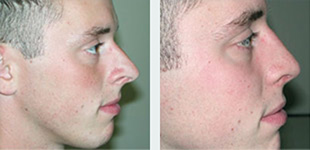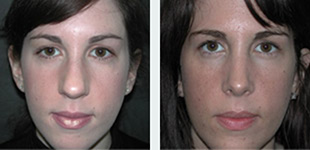The majority of patients who visit Dr. Rival in Toronto for rhinoplasty feel their nose is too large for their face. A large nose generally draws attention away from where the focus should be – on the eyes. The job of a rhinoplasty surgeon is not only to make an attractive looking nose, but to balance it with the rest of the facial features. An experienced facial plastic surgeon will look at the projection of the chin, forehead, and facial width and length in relation to the nasal measurements. All of these factors must be taken into account along with the patient’s height. A small upturned nose generally does not look good on a tall person with a long face. A bump or hump on the bridge of the nose is a common complaint. The bump may be caused by an overgrowth of bone, cartilage or usually both.
What Can the Surgery Do?
To learn more about the possible improvements rhinoplasty surgery (nose jobs) in Toronto or Mississauga, request a rhinoplasty consultation with Dr. Rival at one of his three cosmetic surgery offices in the Toronto area. If you are interested in other types of facial cosmetic surgery, visit Dr. Rival’s main site at rivalcosmeticsurgery.com.
Case Study 1: Nasal Hump
This patient desired a smaller nose overall. Reducing the nasal hump was a major component of her rhinoplasty procedure.
A large nose may also be caused by the tip of the nose sticking too far out from the face. In rhinoplasty terms this tip is overprojected. The rhinoplasty surgeon must carefully reduce the tip while at the same time maintain facial balance and preserve normal nasal breathing function.
Case Study 2: Overprojected Nasal Tip
This patient had an overprojected nasal tip. Tip reduction maneuvers have set it closer to the face. The pictures taken from below show how her tall narrow nostrils are now more rounded with the tip reduction. This also improved her breathing considerably. A large nose may also be caused by the tip of the nose sticking too far out from the face. In rhinoplasty terms this tip is overprojected. The rhinoplasty surgeon must carefully reduce the tip while at the same time maintain facial balance and preserve normal nasal breathing function.
Case Study 3: Over-Projected Tip & Bridge
This patient’s septum and nasal bridge pushed his nose away from his face. Careful reduction rhinoplasty has achieved improved facial balance.
Often the tip of the nose may appear droopy or in rhinoplasty terms “ptotic.” This gives the overall appearance of the nose being long for the face. The experienced rhinoplasty surgeon will rotate and set back the tip just the right amount. A few millimeters can make a huge aesthetic change.
Case Study 4: Large Nasal Bump & Droopy Tip
This patient had a large nasal hump but also a very droopy tip. Tip rotation was achieved to prevent the appearance of a long nose after hump removal.
Case Study 5: Long Nose
Significant tip rotation was achieved here to shorten the nose.
When performing rhinoplasty in Toronto for male patients, Dr. Rival strives to maintain a strong bridge. Over reduction of the bridge or over rotation of the tip can make a male nose look too feminine.
Case Study 6: Male Rhinoplasty
This patient had his nasal hump removed while maintaining a strong bridge and male profile.
Often the nasal tip is large, round like a ball or boxy. Rhinoplasty can reshape the tip to give it a more triangular shape with better definition. The amount of change possible is often dependent on how thick the overlying skin is. Thick skin will not contract or shrink around the new nasal structure as well as thin skin will. The rhinoplasty surgeon must take this into account when performing tip surgery.
Case Study 7: Large, Round Tip
Advanced techniques were used to obtain improved nasal tip definition and narrowing in this patient with very thick skin and a large nasal tip.
Sometimes the overall nose is wide from the bridge down to the tip. A properly performed rhinoplasty can narrow the nose and bring it into better facial balance.
Case Study 8: Wide Nose
This patient’s rhinoplasty was done to narrow the bridge, tip and nostrils.
A twisted or deviated nose is a common and challenging problem in rhinoplasty. This may be related to previous nasal trauma or be genetic. An important component of correction here is straightening of the midline partition of the nose or “septoplasty.” An experienced rhinoplasty surgeon will have a variety of techniques at his disposable to obtain the straightest nose possible.
Case Study 9: Crooked Nose
This patient with significant deviation of both the bony (upper third) and cartilaginous (lower 2/3) components of the nose. Although a perfectly straight nose is rarely obtained he is very happy with the improvement.
While most patients desire a smaller nose, some benefit from augmentation to achieve improvement. This is often caused by trauma or previous nasal surgery. While there are a number of possible materials available to reconstruct the nasal framework, Dr. Rival prefers to use the patient’s own cartilage usually obtained from inside the nose.
Case Study 10: Revision Rhinoplasty
This patient had previous overly aggressive surgery performed elsewhere. Dr. Rival used cartilage from inside the nose (septum) and the ear to rebuild the nasal structure. Read more about Revision Rhinoplasty.
Some noses have marked asymmetry where one side is very different then the other. While it is impossible to obtain perfect symmetry, a skilled rhinoplasty surgeon can make a major improvement.
Case Study 11: Asymmetry
This patient elected to have rhinoplasty to fix the marked asymmetry between his two nostrils.










